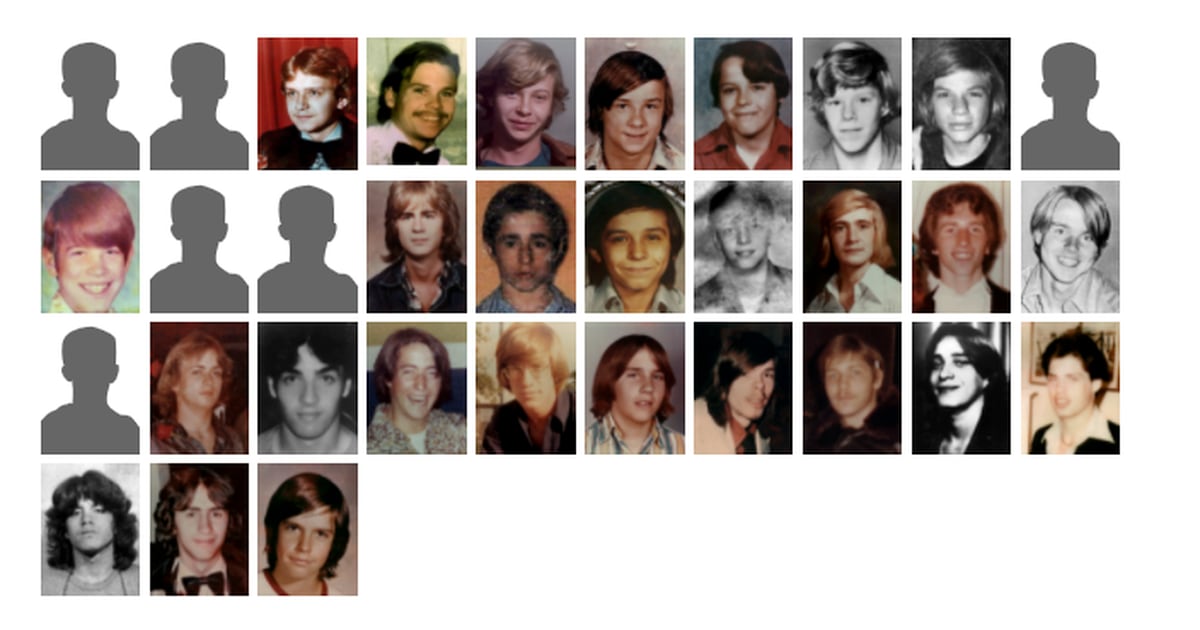When it comes to infamous figures in American history, Michael Gacy stands as a chilling reminder of the darkness that can lurk beneath the surface of everyday life. Known as the "Killer Clown," his story is one that continues to haunt the annals of crime history. But who was Michael Gacy, really? What drove him to commit such heinous acts, and how did he manage to deceive so many for so long? In this deep dive, we’ll uncover the man behind the moniker, exploring his life, crimes, and legacy.
Michael Gacy’s tale is not just a crime story; it’s a psychological exploration of the human capacity for evil. His ability to charm and deceive while committing unimaginable atrocities raises profound questions about trust, perception, and the thin line between good and evil. As we peel back the layers of his life, we’ll uncover the chilling reality of how a seemingly ordinary man became one of the most notorious serial killers in history.
Through this article, we’ll delve into the darkest corners of Gacy’s life, examining the factors that shaped his twisted psyche and the impact of his actions on his victims and their families. So, buckle up and prepare to journey into the mind of a monster—a journey that will challenge your understanding of human nature.
Read also:Takahiro Moriuchi Married The Inside Story You Need To Know
Table of Contents
- Michael Gacy's Biography
- Early Life and Formative Years
- Career Path and Public Persona
- The Infamous "Killer Clown"
- Crimes Committed: The Grim Details
- The Investigation and Arrest
- The Trial: Justice for the Victims
- Psychological Profile: Understanding the Mind of a Monster
- Impact on Society: Lessons Learned
- Michael Gacy's Legacy: A Lasting Nightmare
Michael Gacy's Biography
Let’s start with the basics. Michael John Gacy Jr. was born on March 17, 1942, in Chicago, Illinois. He grew up in a middle-class family, surrounded by the typical trappings of suburban life. But beneath the surface, there were signs of the turmoil that would later define his life. Gacy’s childhood was marred by physical and emotional abuse from his father, a volatile alcoholic who often lashed out at his son.
As he grew older, Gacy cultivated a public persona that was the epitome of charm and success. He became a prominent figure in his community, known for his work as a contractor and his involvement in local politics. But behind closed doors, a darker side emerged—one that would eventually lead to the discovery of his darkest secrets.
Biographical Data
| Full Name | Michael John Gacy Jr. |
|---|---|
| Date of Birth | March 17, 1942 |
| Place of Birth | Chicago, Illinois, USA |
| Occupation | Contractor, Politician, Clown Performer |
| Known For | Serial Killer, "Killer Clown," Murder of 33 Young Men and Boys |
Early Life and Formative Years
Growing up, Michael Gacy faced a tumultuous home environment. His father, Michael Sr., was a harsh and unforgiving figure, often berating his son for perceived failures. This constant criticism left a lasting impact on young Michael, shaping his self-perception and fueling a desire to prove himself to the world. But it also instilled a deep sense of insecurity that would later manifest in his adult life.
Gacy’s early years were also marked by a series of health issues. At the age of 11, he suffered a severe head injury after being struck by a swing in a schoolyard accident. Some experts speculate that this incident may have contributed to his later psychological issues, though the exact connection remains unclear. Despite these challenges, Gacy managed to excel academically, graduating from high school and later attending business school.
Career Path and Public Persona
After completing his education, Gacy embarked on a career in construction, quickly rising through the ranks to become a successful contractor. He was known for his charm and charisma, traits that helped him build a network of influential contacts in the Chicago area. But his ambitions didn’t stop there. Gacy also dabbled in local politics, running for public office and using his position to further his social standing.
Perhaps most famously, Gacy donned the persona of "Pogo the Clown," entertaining at children’s parties and community events. This alter ego allowed him to bask in the adoration of those around him, masking the darkness that lurked beneath the surface. To the outside world, Michael Gacy was a pillar of the community—a man who gave back and inspired those around him. But as we’ll soon discover, the truth was far more sinister.
Read also:Pablo Torre Wife Photo A Closer Look At His Life Love And Journey
The Infamous "Killer Clown"
The nickname "Killer Clown" became synonymous with Michael Gacy, and for good reason. Behind the painted smile and colorful costume, Gacy committed some of the most heinous crimes in American history. Over the course of several years, he lured young men and boys to their deaths, often enticing them with promises of work or companionship. Once in his clutches, they faced unimaginable horrors.
But how did Gacy manage to deceive so many? Part of his success lay in his ability to manipulate and charm. He was a master of disguise, using his public persona to deflect suspicion and gain the trust of those around him. His victims were often vulnerable, seeking work or a place to stay, and Gacy exploited their desperation to his advantage.
Crimes Committed: The Grim Details
The full extent of Gacy’s crimes only came to light after his arrest in 1978. Investigators discovered the remains of 29 victims buried beneath his home, with additional bodies found in nearby waterways. The victims ranged in age from 14 to 21, each with their own story of hope and promise cut tragically short.
- Victims were often lured to Gacy’s home under false pretenses.
- Once inside, they were subjected to torture, sexual assault, and ultimately murder.
- Gacy meticulously documented his crimes, keeping detailed records and even photographing some of his victims.
The sheer scale of his atrocities shocked the nation, raising questions about how such a monster could operate undetected for so long. As the investigation unfolded, it became clear that Gacy’s charm and social standing had helped shield him from scrutiny, allowing him to continue his reign of terror.
The Investigation and Arrest
Gacy’s downfall began in December 1978, when police were called to investigate the disappearance of Robert Piest, a 15-year-old boy last seen leaving his job at a local pharmacy with Gacy. Officers conducted a search of Gacy’s home, uncovering evidence that would eventually lead to his arrest. During the search, they discovered a series of disturbing photographs and personal items belonging to missing individuals.
As the investigation deepened, authorities uncovered the horrifying truth about Gacy’s crimes. The discovery of the bodies buried beneath his home sent shockwaves through the community, prompting a massive manhunt for the remaining victims. Gacy was arrested on December 21, 1978, and charged with multiple counts of murder.
The Trial: Justice for the Victims
Gacy’s trial, which began in February 1980, was a media sensation. The prosecution presented a mountain of evidence against him, including witness testimony, forensic analysis, and his own confessions. Despite his attempts to plead insanity, the jury found Gacy guilty on all counts, sentencing him to death for 12 of the murders.
During the trial, Gacy’s defense team argued that his traumatic childhood and head injury had contributed to his criminal behavior. However, the prosecution successfully countered these claims, presenting a compelling case that Gacy was fully aware of his actions and acted with deliberate intent. In the end, justice was served, though it came too late for the families of his victims.
Psychological Profile: Understanding the Mind of a Monster
What drives someone to commit such heinous acts? Psychologists have long debated the factors that contributed to Gacy’s transformation into a serial killer. While there is no single answer, several key elements stand out:
- Trauma and Abuse: Gacy’s childhood experiences of abuse and neglect likely played a significant role in shaping his psyche.
- Head Injury: The severe head injury he suffered as a child may have contributed to cognitive and emotional impairments.
- Desire for Control: Gacy’s need for dominance and control over others was a recurring theme in his crimes.
Despite these insights, the full complexity of Gacy’s mind remains elusive. His ability to compartmentalize his life, maintaining a façade of normalcy while committing unimaginable atrocities, continues to baffle experts to this day.
Impact on Society: Lessons Learned
Gacy’s crimes had a profound impact on American society, sparking widespread discussions about the nature of evil and the importance of vigilance. His case highlighted the dangers of trusting outward appearances and the need for greater awareness of mental health issues. It also prompted changes in law enforcement practices, emphasizing the importance of thorough background checks and community engagement.
Today, Gacy’s story serves as a cautionary tale, reminding us that monsters can wear many masks. By understanding the factors that contribute to such crimes, we can work to prevent them in the future and honor the memory of those who lost their lives to his brutality.
Michael Gacy's Legacy: A Lasting Nightmare
Decades after his execution in 1994, Michael Gacy remains a haunting figure in the annals of crime history. His legacy is one of fear and tragedy, a stark reminder of the darkness that can exist within even the most ordinary-seeming individuals. But it is also a call to action, urging us to remain vigilant and compassionate in our pursuit of justice and understanding.
As we reflect on Gacy’s life and crimes, we are reminded of the importance of empathy, awareness, and action. By learning from the past, we can build a safer, more compassionate future—one where such horrors are less likely to occur.
Final Thoughts
In conclusion, Michael Gacy’s story is a chilling reminder of the complexities of human nature. From his troubled childhood to his rise as a prominent community figure, every aspect of his life sheds light on the factors that contributed to his descent into darkness. As we’ve explored, Gacy’s crimes were not just a personal tragedy but a societal failure, one that demands our attention and reflection.
So, what can we take away from this dark chapter in history? First and foremost, we must remain vigilant, questioning the motives and actions of those around us. We must also prioritize mental health and support those who may be struggling in silence. And finally, we must honor the memory of Gacy’s victims by striving to create a world where such atrocities are less likely to occur.
Now it’s your turn. What are your thoughts on Michael Gacy’s story? Do you think we’ve learned enough from his crimes to prevent similar tragedies in the future? Share your insights in the comments below, and don’t forget to check out our other articles for more fascinating insights into the human condition.



